Why Meteorology at South?
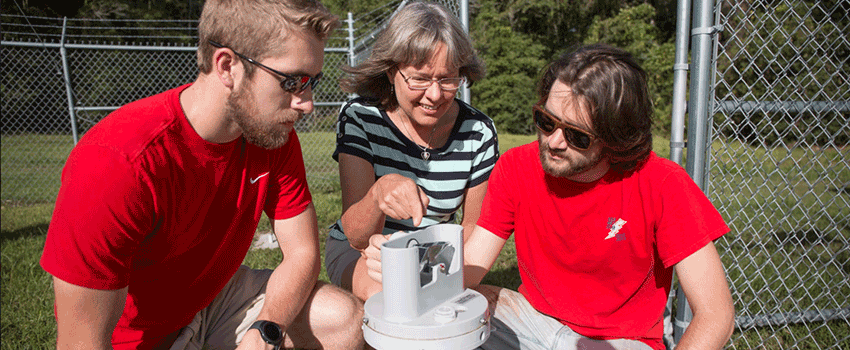
The University of South Alabama is a state university consisting of ten schools and colleges. Established in 1963, USA has steadily grown to an enrollment of approximately 15,000 students and nearly 800 faculty.
The meteorology program began in 1991 as a concentration in geography and graduated its first student in 1995. In 1999, the Alabama Commission on Higher Education officially granted a "Bachelor of Science in Meteorology." Meteorology is taught in the College of Arts and Sciences and is part of the Department of Earth Sciences, which also includes the disciplines of geography and geology.
Why study meteorology at the University of South Alabama?
Take a look at what we have to offer:
- Sound Curriculum Focused on Career Outcomes
- Small Classes and Individual Training
- On-Campus Weather Forecasting Center
- Gulf Coast Weather: Experiencing a Natural Laboratory
- A Research-Quality Network of Weather Stations
Sound Curriculum
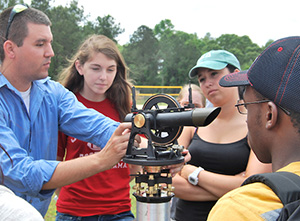
The University of South Alabama offers a curriculum designed to provide each student with a thorough understanding of the laws of atmospheric behavior. Each student is exposed to the latest techniques in weather forecasting and atmospheric remote sensing. As a preparation for a career in forecasting, the procedures and importance of disseminating weather information to the public and industry are stressed.
Because of close ties with the National Weather Service, the U.S. Army Corps of Engineers, Keesler Air Force Base, local television stations, and major industries, students have the opportunity to visit and observe meteorologists in the field and discuss the importance of weather with those who depend on accurate and timely weather information.
Students completing the meteorology curriculum will have a Bachelor of Science Degree in Meteorology. In order to prepare students for the many diverse areas of meteorological employment and future study, three tracks of study are offered that enable students to specialize in such areas as professional forecasting, broadcast, and graduate school preparation. (See our page on the meteorology curriculum.)
Small Classes and Individual Training
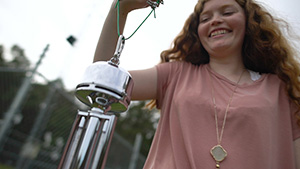 Although South has grown tremendously since its inception in 1963, classes remain
small and, contrary to many other universities, are taught only by the faculty. The
small class size makes it possible for the faculty to provide individual attention.
Students are closely advised and counseled as they progress through their meteorology
curriculum with an emphasis on post graduate employment. This close supervision enables
the faculty to direct each student toward an appropriate position in what has become
a field with a promising job market. With the focus on global warming, our fragile
environment, and the escalating costs of adverse and severe weather, meteorologists
will play an important role in the scientific community over the next few decades.
Although South has grown tremendously since its inception in 1963, classes remain
small and, contrary to many other universities, are taught only by the faculty. The
small class size makes it possible for the faculty to provide individual attention.
Students are closely advised and counseled as they progress through their meteorology
curriculum with an emphasis on post graduate employment. This close supervision enables
the faculty to direct each student toward an appropriate position in what has become
a field with a promising job market. With the focus on global warming, our fragile
environment, and the escalating costs of adverse and severe weather, meteorologists
will play an important role in the scientific community over the next few decades.
For example, meteorologists are now found in many areas including the National Weather Service, the military, private and governmental research centers, teaching, county and state environmental agencies, private weather services, oil and gas, transportation, and other private companies, and the media.
On-Campus Weather Forecasting Center
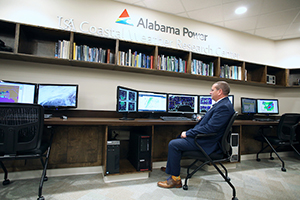 The Alabama Power USA Coastal Weather Research Center is located on the main campus of the University of South Alabama. The Weather Center
is a fully-operational weather forecast center, a unique facility for any college
in the nation. It plays a key role in the meteorology program by providing a nucleus
for students and faculty to gather and discuss weather and engage in research projects.
The Alabama Power USA Coastal Weather Research Center is located on the main campus of the University of South Alabama. The Weather Center
is a fully-operational weather forecast center, a unique facility for any college
in the nation. It plays a key role in the meteorology program by providing a nucleus
for students and faculty to gather and discuss weather and engage in research projects.
The presence of the Coastal Weather Research Center on the campus provides the meteorology student with the opportunity to experience weather forecasting and industrial meteorology first hand. An array of equipment and workstations allows each student meteorologist to have access to the same radar, satellite, and alphanumeric data that are used by the forecasting staff. In addition, students will have the chance to work at the Weather Center where they can combine classroom theory with actual weather forecasting applications.
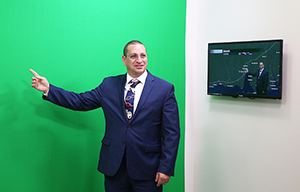 The Alabama Power USA Coastal Weather Research Center was designed to promote and
support meteorological education and research through:
The Alabama Power USA Coastal Weather Research Center was designed to promote and
support meteorological education and research through:
- Meteorology workshops and seminars
- A climatological and hurricane data archive
- Research on the interaction of coastal and oceanic environments
- The operation of a weather laboratory and information center
Through the interest and support of local and regional industry and the University community, the Weather Center has been able to effectively pursue its objectives.
A strong and active part of the Weather Center's operation is a state-of-the-art information center and weather laboratory. A variety of weather information, such as forecasts, severe weather alerts, and climate data is provided to businesses, industries, and municipal governments in Alabama, Florida, and Mississippi. The Computerized Weather Information Service transmits Weather Center and National Weather Service information to businesses 24 hours daily.
The South Alabama Mesonet
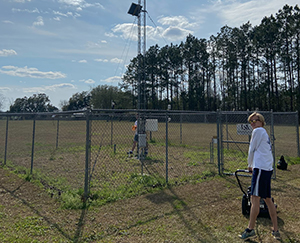
Founded in 2006, the South Alabama Mesonet consists of 25 research-grade automated weather stations. Data is collected every minute and disseminated to the National Weather Service and other users including power companies, nurseries, and fire stations. The Mesonet is used extensively in the meteorology curriculum and in undergraduate research. It also provides paid positions for student technicians to maintain and troubleshoot stations.
The Mesonet is entirely funded through grants and donations to support routine maintenance (removing vegetation and animal nests), sensor replacement/repair, calibration of instruments, and to pay student workers. Mesonet weather station data have inspired a wide variety of research projects at the University of South Alabama addressing local weather events and phenomena including cold fronts, landfall of tropical storms, sea breezes, nocturnal cooling, and local wind and rainfall climatologies. Meteorology majors can take a class in Meteorological Instrumentation, get involved in weather station maintenance, social media outreach and participate in research projects using Mesonet data. The Mobile National Weather Service forecast office uses the data on a frequent basis to issue severe weather and flash flood warnings and to perform post weather event analyses. Thirteen stations are located on local public school campuses and are used for K-12 outreach activities.
Gulf Coast Weather: Experiencing a Natural Laboratory
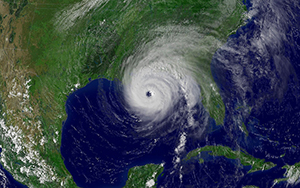 The Mobile area and the Alabama Gulf Coast is a virtual weather laboratory where students
can experience many of the weather phenomena studied in the classroom. What could
be better than to study meteorology in Mobile, one of the wettest major cities in
the United States with one of the highest thunderstorm frequencies in the nation.
Then, in the summer and fall, all eyes focus on the warm waters of the Gulf of Mexico
and the Caribbean as hurricane season unfolds. Although direct hurricane landfalls
on the Mobile area are rare, the region often receives fringe effects of Gulf hurricanes
as far away as Texas. Because of this threat, hurricanes are taken seriously by the
local residents and the business community and thus are given special attention in
the meteorology curriculum, as are all forms of severe weather.
The Mobile area and the Alabama Gulf Coast is a virtual weather laboratory where students
can experience many of the weather phenomena studied in the classroom. What could
be better than to study meteorology in Mobile, one of the wettest major cities in
the United States with one of the highest thunderstorm frequencies in the nation.
Then, in the summer and fall, all eyes focus on the warm waters of the Gulf of Mexico
and the Caribbean as hurricane season unfolds. Although direct hurricane landfalls
on the Mobile area are rare, the region often receives fringe effects of Gulf hurricanes
as far away as Texas. Because of this threat, hurricanes are taken seriously by the
local residents and the business community and thus are given special attention in
the meteorology curriculum, as are all forms of severe weather.






